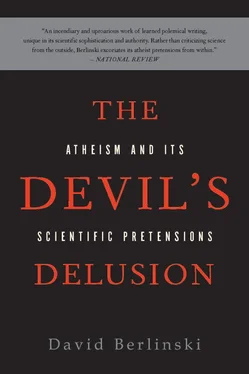The first argument asks of a finite universe how it emerged; the second of an infinite universe why it is there.
The first demands a cause; the second, a reason.
Both arguments are inferences to God, but they proceed from different sources in the imagination.
A causally successful God is what He seems: By creating the universe, He has gotten the job done, and if in return He demands a good deal by way of worshipful admiration, who is to gainsay Him?
A God who functions as a reason is occupied with what German metaphysicians might call the foundations of being. He functions as an anchor and so as a refuge.
Both Gods are equally necessary, but the God engaged in anchoring the universe does not necessarily bother himself with its creation. Why should He? The thing has been there forever. His role is otherwise, and it is more fundamental. It is to this lofty and remote deity that the human heart turns when it wishes to assure itself that there is one thing in Being answering to the majesty of I AM THAT I AM.
God is in this sense an answer to the question long posed by metaphysicians: Why is there something rather than nothing? If anything exists contingently, the second cosmological argument affirms, at least one thing exists necessarily. There is something rather than nothing, because at least one part of existence has its origins in what must be. As for the rest of creation, in one way or another it may be allowed to take care of itself. In reaching for a God who exists necessarily, the theologians have covered their most important base.
And the scientists, until now scoffing at the sidelines, what have they to say about all this?
In the early years of the nineteenth century, the English polymath Thomas Young demonstrated that light behaves like a wave. After shining a beam of light through two slits, he observed interference patterns forming on a screen placed behind them. Wave crests met wave crests to form bigger crests; wave troughs met wave troughs to form deeper troughs; and when crests and troughs were not meeting companionably, they interfered with one another in order to extinguish themselves.
What could be simpler? Light is like a wave.
Ah, but on the other hand, Einstein demonstrated in 1905 that in order to explain the photoelectric effect, it was necessary (or at least convenient) to assume that light comprises particles. Send a beam of light toward a metal surface, and electrons pop out. Plainly they pop out because they have been knocked off. To accommodate both popping out and knocking off, Einstein found it necessary to think of light as if it were composed of discrete packets of energy.
What could be simpler? Light is like a particle.
It was not entirely clear how in the matter of Young v. Einstein, both men could have been right.
The consortium of physicists who created quantum mechanics in the third decade of the twentieth century—Neils Bohr, Werner Heisenberg, Erwin Schrödinger, Max Born—finessed this problem by declaring Young v. Einstein a draw. Light, they argued, is both like a wave and like a particle, and what is more, it is like a wave and like a particle on the level of individual photons themselves. Photons, physicists came to understand, interfere with themselves, and if deep down no one had the slightest idea how to picture autointerference, what physicists were willing to give up was the picture and not the interference.
The finessing required, as one might imagine, a good deal of finesse.
A quantum particle—an electron or a photon, say—is here, and somewhat later, it is there. The old here-and-there, Schrödinger specified in terms of the properties of a wave. It is here where the wave mounts and there where it dips. Passing through two slits, the wave peaks at the left and peaks as well at the right, flowing, as waves tend to do, through both slits at once.
But a wave is intended to track the moving position of a single particle, and it is here that the formalism of quantum mechanics commits the physicist to a form of legerdemain that has to this day resisted all attempts at explication. It is one thing to say that a wave may pass through two slits; it is quite another thing to say that a single particle may divide its allegiance in just the same way. Nonetheless, this is just what physicists were forced to say. By now, they say it without a second thought. The particle that could be here or there they represent by a wave that is here and there. If that is where the wave is, the particle enjoys a doubling of its position in space, with each position corresponding to a distinct physical state. Somehow both physical states are real and they are real at the same time. They are, as physicists say, superimposed. They exist together. There is no getting rid of them. Superimposed states are themselves described by the undulation of a wave, which is generally described as a wave packet to signify the extent to which it embodies a variety of different quantum states and so a variety of separate waves. It is Schrödinger’s equation that describes the wave packets’ undulations.
The formalism of quantum mechanics, physicists at once realized, defeated all efforts to picture the quantum world. If no pictures were available, neither was there a link to common sense. Light is both a wave and a particle, and it is both a wave and a particle at the same time. This conclusion embodies a mystery, one that no subsequent analytical efforts have dissolved. The mystery will not appear entirely unfamiliar to Christians persuaded of the threefold aspect of the deity. If light is a particle and a wave, religious believers might observe, God is a Father, a Son, and a Holy Ghost. This is not an analogy that has captured the allegiance of scientific atheists.
The interpretation of quantum mechanical formalism did little to dispel the mystery it embodied. In 1926, Max Born provided the standard scheme by which the equations of quantum mechanics might be understood. The details are complex, but in a rough-and-ready way, Born suggested that the quantum mechanical waves passing sedately throughout the universe might be understood in terms of the probabilities that they reveal. Thus the amplitude of a wave is a sign that quite likely there is a particle there and so a clue to its position, and the distance between wave peaks is again a sign that quite likely the particle is traveling with a particular momentum. A wave with two peaks rising like the devil’s horns might represent a particle dividing its allegiances equally between two slits.
Under Born’s interpretation of quantum mechanics, the identity of a particle undergoes further deconstruction. The old here-or-there has long since passed to the new here- and -there, but what is here and there is now a matter of chance. Having impossibly divided itself between two slits, a single photon undergoes further demotion to appear in quantum mechanics as the ghost of its position. It could be here, it could be there, and somehow it could be at both places at once.
These divided allegiances come to an end abruptly when an observer, padding in from outside the quantum system, undertakes a measurement. So long as no one is looking, the electron is all things to all men. But let the physicist have a look, and boom! the particle that could be here and there becomes here or there all over again. The wave packet collapses into just one of its possibilities. The other quantum states that it embodies vanish, and they vanish instantaneously.
No one knows why.
Niels Bohr—widely considered to be inscrutable in his conversation, owing to the particular flavor of his Danish Grope and Mumble—embraced this interpretation of quantum mechanics, whence its designation as the Copenhagen interpretation. It has become canonical.
Читать дальше












